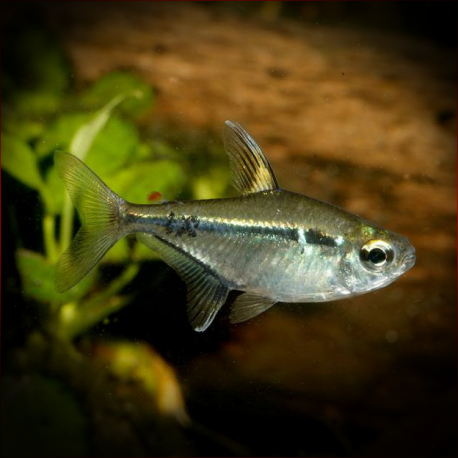More info
Datasheet
| Minimum Tank Size | 70 litres / 18.49 US gallons |
| Maximum Size | 5.0cm / 1.97inches |
| Temperature | 23°C / 73.40°F - 27°C / 80.60°F |
| Hardness | 5-12ºdH |
| pH | 6.0-7.0 |
General Description
The Broken-Line Tetra, scientifically known as Hemigrammus Ulreyi, is a peaceful species belonging to the Characidae family. They are typically small, reaching a maximum size of about 5.0cm. Often misidentified, the true H. Ulreyi is a rare but visually appealing addition to most aquariums.
Aquarium Setup
For optimal care, a minimum tank size of 70 litres is recommended. A biotope setup mimicking their natural habitat with river sand, driftwood, dried leaves, and dim lighting is suitable. In captivity, they thrive in groups of at least 6 individuals and are best kept with other South American species such as other Hemigrammus or Hyphessobrycon species, pencil fish, and small cichlids.
Behaviour
These tetras are known for their peaceful nature and shoaling behavior. They do best when kept in schools of 10 or more, showing off their best colors and natural shoaling behavior. While they can coexist with larger fish like cichlids, it's essential to ensure tankmates are not overly aggressive to prevent stress.
Feeding and Diet
Broken-Line Tetras are easy to feed, accepting a variety of foods. Their diet should consist of small live and frozen foods like bloodworms, Daphnia, brine shrimp, along with high-quality flakes and granules. Regular feeding ensures their health and vibrant colors.
Reproduction & Dimorphism
Breeding H. Ulreyi involves setting up a separate tank with soft, acidic water, dim lighting, and fine-leaved plants for egg deposition. Adult females are larger and more rounded in the belly than males. Eggs hatch in 24-36 hours, with fry becoming free-swimming a few days later and requiring infusoria-type food initially.
Habitat and Distribution
In the wild, Broken-Line Tetras are native to the slow-moving rivers and tributaries of the Brazilian part of the Rio Paraguay basin. They prefer soft, acidic water conditions with a pH range of 6.0-7.0, hardness of 5-12°dH, and a temperature range of 23-27°C.

